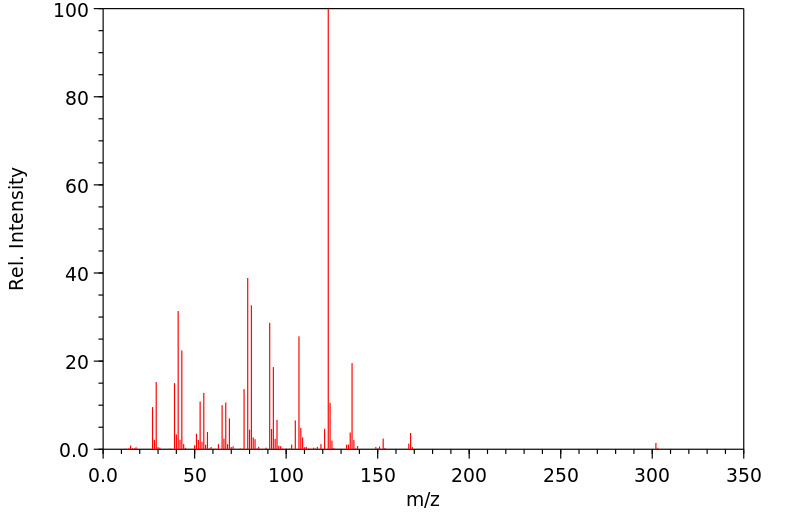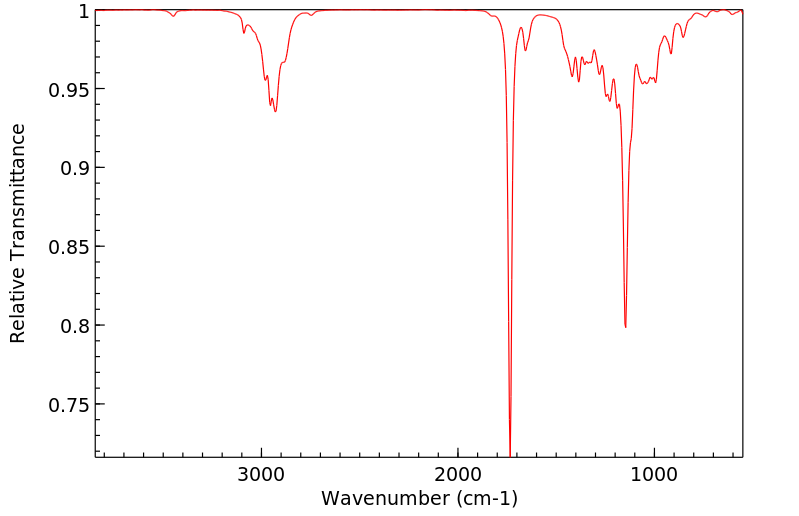烯丙菊酯 | 584-79-2
-
物化性质
-
计算性质
-
ADMET
-
安全信息
-
SDS
-
制备方法与用途
-
上下游信息
-
文献信息
-
表征谱图
-
同类化合物
-
相关功能分类
-
相关结构分类
物化性质
-
熔点:approximate 4℃
-
沸点:160°C
-
密度:1.01
-
闪点:66 °C
-
溶解度:氯仿:微溶
-
LogP:4.780
-
物理描述:Allethrin appears as a clear amber-colored viscous liquid. Insoluble and denser than water. Toxic by ingestion, inhalation, and skin absorption. A synthetic household insecticide that kills flies, mosquitoes, garden insects, etc.
-
蒸汽压力:Vapor pressure, Pa at 20 °C:
-
保留指数:2063;2034;2053;2060.7;2048.1
-
稳定性/保质期:
计算性质
-
辛醇/水分配系数(LogP):4.8
-
重原子数:22
-
可旋转键数:6
-
环数:2.0
-
sp3杂化的碳原子比例:0.578
-
拓扑面积:43.4
-
氢给体数:0
-
氢受体数:3
ADMET
安全信息
-
危险等级:6.1(b)
-
危险品标志:Xn,N
-
安全说明:S23,S24/25,S36,S36/37,S60,S61
-
危险类别码:R20/22,R50/53
-
WGK Germany:3
-
海关编码:29183000
-
RTECS号:GZ1925000
-
包装等级:III
-
危险类别:6.1(b)
-
危险品运输编号:UN 3082
-
储存条件:单独贮存,通风、低温、干燥。
SDS
: Es-生物烯丙菊酯
产品名称
1.2 鉴别的其他方法
无数据资料
1.3 有关的确定了的物质或混合物的用途和建议不适合的用途
仅供科研用途,不作为药物、家庭备用药或其它用途。
模块 2. 危险性概述
2.1 GHS分类
急性毒性, 经口 (类别4)
急性毒性, 吸入 (类别4)
急性水生毒性 (类别1)
2.2 GHS 标记要素,包括预防性的陈述
象形图
警示词 警告
危险申明
H302 吞咽有害。
H332 吸入有害。
H400 对水生生物毒性极大。
警告申明
预防
P261 避免吸入粉尘/烟/气体/烟雾/蒸气/喷雾.
P264 操作后彻底清洁皮肤。
P270 使用本产品时不要进食、饮水或吸烟。
P271 只能在室外或通风良好之处使用。
P273 避免释放到环境中。
措施
P301 + P312 如果吞下去了: 如感觉不适,呼救解毒中心或看医生。
P304 + P340 如吸入,将患者移至新鲜空气处并保持呼吸顺畅的姿势休息.
P312 如感觉不适,呼救中毒控制中心或医生.
P330 漱口。
P391 收集溢出物。
处理
P501 将内容物/ 容器处理到得到批准的废物处理厂。
2.3 其它危害物 - 无
模块 3. 成分/组成信息
3.1 物 质
: C19H26O3
分子式
: 302.41 g/mol
分子量
组分 浓度或浓度范围
Allethrin
-
CAS 号 584-79-2
EC-编号 209-542-4
索引编号 006-025-00-3
模块 4. 急救措施
4.1 必要的急救措施描述
一般的建议
请教医生。 出示此安全技术说明书给到现场的医生看。
吸入
如果吸入,请将患者移到新鲜空气处。 如果停止了呼吸,给于人工呼吸。 请教医生。
皮肤接触
用肥皂和大量的水冲洗。 请教医生。
眼睛接触
用水冲洗眼睛作为预防措施。
食入
切勿给失去知觉者从嘴里喂食任何东西。 用水漱口。 请教医生。
4.2 主要症状和影响,急性和迟发效应
据我们所知,此化学,物理和毒性性质尚未经完整的研究。
4.3 及时的医疗处理和所需的特殊处理的说明和指示
无数据资料
模块 5. 消防措施
5.1 灭火介质
灭火方法及灭火剂
用水雾,耐醇泡沫,干粉或二氧化碳灭火。
5.2 源于此物质或混合物的特别的危害
碳氧化物
5.3 给消防员的建议
如必要的话,戴自给式呼吸器去救火。
5.4 进一步信息
无数据资料
模块 6. 泄露应急处理
6.1 人员的预防,防护设备和紧急处理程序
使用个人防护设备。 防止吸入蒸汽、气雾或气体。 保证充分的通风。 将人员撤离到安全区域。
6.2 环境保护措施
在确保安全的前提下,采取措施防止进一步的泄漏或溢出。 不要让产物进入下水道。
防止排放到周围环境中。
6.3 抑制和清除溢出物的方法和材料
用惰性吸附材料吸收并当作危险废品处理。 存放进适当的闭口容器中待处理。
6.4 参考其他部分
丢弃处理请参阅第13节。
模块 7. 操作处置与储存
7.1 安全操作的注意事项
避免接触皮肤和眼睛。 防止吸入蒸汽和烟雾。
7.2 安全储存的条件,包括任何不兼容性
贮存在阴凉处。 容器保持紧闭,储存在干燥通风处。
打开了的容器必须仔细重新封口并保持竖放位置以防止泄漏。
7.3 特定用途
无数据资料
模块 8. 接触控制和个体防护
8.1 容许浓度
最高容许浓度
没有已知的国家规定的暴露极限。
8.2 暴露控制
适当的技术控制
按照良好工业和安全规范操作。 休息前和工作结束时洗手。
个体防护设备
眼/面保护
面罩與安全眼鏡请使用经官方标准如NIOSH (美国) 或 EN 166(欧盟) 检测与批准的设备防护眼部。
皮肤保护
戴手套取 手套在使用前必须受检查。
请使用合适的方法脱除手套(不要接触手套外部表面),避免任何皮肤部位接触此产品.
使用后请将被污染过的手套根据相关法律法规和有效的实验室规章程序谨慎处理. 请清洗并吹干双手
所选择的保护手套必须符合EU的89/686/EEC规定和从它衍生出来的EN 376标准。
沉浸保护
联合国运输名称: 丁腈橡胶
最小的层厚度 0.11 mm
溶剂渗透时间: > 480 min
测试过的物质Dermatril® ( Z677272, 规格 M)
飞溅保护
联合国运输名称: 丁腈橡胶
最小的层厚度 0.11 mm
溶剂渗透时间: > 30 min
测试过的物质Dermatril® ( Z677272, 规格 M)
0, 测试方法 EN374
如果以溶剂形式应用或与其它物质混合应用,或在不 同于EN
374规定的条件下应用,请与EC批准的手套的供应 商联系。
这个推荐只是建议性的,并且务必让熟悉我们客户计划使用的特定情况的工业卫生学专家评估确认才可.
这不应该解释为在提供对任何特定使用情况方法的批准.
身体保护
全套防化学试剂工作服, 防护设备的类型必须根据特定工作场所中的危险物的浓度和含量来选择。
呼吸系统防护
如危险性评测显示需要使用空气净化的防毒面具,请使用全面罩式多功能防毒面具(US)或ABEK型
(EN
14387)防毒面具筒作为工程控制的候补。如果防毒面具是保护的唯一方式,则使用全面罩式送风防
毒面具。 呼吸器使用经过测试并通过政府标准如NIOSH(US)或CEN(EU)的呼吸器和零件。
模块 9. 理化特性
9.1 基本的理化特性的信息
a) 外观与性状
形状: 液体
b) 气味
无数据资料
c) 气味阈值
无数据资料
d) pH值
无数据资料
e) 熔点/凝固点
无数据资料
f) 起始沸点和沸程
无数据资料
g) 闪点
66.00 °C
h) 蒸发速率
无数据资料
i) 易燃性(固体,气体)
无数据资料
j) 高的/低的燃烧性或爆炸性限度 无数据资料
k) 蒸汽压
无数据资料
l) 蒸汽密度
无数据资料
m) 相对密度
0.997 g/cm3 在 20 °C
n) 水溶性
不溶
o) n-辛醇/水分配系数
无数据资料
p) 自燃温度
无数据资料
q) 分解温度
无数据资料
r) 粘度
无数据资料
模块 10. 稳定性和反应活性
10.1 反应性
无数据资料
10.2 稳定性
无数据资料
10.3 危险反应的可能性
无数据资料
10.4 应避免的条件
无数据资料
10.5 不兼容的材料
强氧化剂
10.6 危险的分解产物
其它分解产物 - 无数据资料
模块 11. 毒理学资料
11.1 毒理学影响的信息
急性毒性
半数致死剂量 (LD50) 经口 - 大鼠 - 685 mg/kg
半数致死浓度(LC50) 吸入 - 老鼠 - > 2,000 mg/m3
半数致死剂量 (LD50) 经皮 - 兔子 - 11,332 mg/kg
备注: 行为的:震颤。 行为的:兴奋。
皮肤刺激或腐蚀
无数据资料
眼睛刺激或腐蚀
无数据资料
呼吸道或皮肤过敏
无数据资料
生殖细胞突变性
细胞突变性-体外试验 - 仓鼠 - 肺
细胞发生分析
细胞突变性-体外试验 - Ames 试验(艾姆斯试验) - 鼠伤寒沙门氏菌
细胞突变性-体外试验 - 人 - 成纤维细胞 - 阴性
非常规DNA合成
致癌性
IARC:
此产品中没有大于或等于 0。1%含量的组分被 IARC鉴别为可能的或肯定的人类致癌物。
生殖毒性
无数据资料
特异性靶器官系统毒性(一次接触)
无数据资料
特异性靶器官系统毒性(反复接触)
无数据资料
吸入危险
无数据资料
潜在的健康影响
吸入 吸入有害。 可能引起呼吸道刺激。
摄入 误吞对人体有害。
皮肤 如果通过皮肤吸收可能是有害的。 可能引起皮肤刺激。
眼睛 可能引起眼睛刺激。
接触后的征兆和症状
据我们所知,此化学,物理和毒性性质尚未经完整的研究。
附加说明
化学物质毒性作用登记: GZ1925000
模块 12. 生态学资料
12.1 生态毒性
对鱼类的毒性 半数致死浓度(LC50) - Carassius carassius (鲤鱼) - 0.032 mg/l - 96.0 h
对水蚤和其他水生无脊 半致死有效浓度(EC50) - Daphnia pulex (水蚤) - 0.021 mg/l - 48 h
椎动物的毒性
12.2 持久存留性和降解性
无数据资料
12.3 潜在的生物蓄积性
无数据资料
12.4 土壤中的迁移性
无数据资料
12.5 PBT 和 vPvB的结果评价
无数据资料
12.6 其它不利的影响
对水生生物毒性极大。
模块 13. 废弃处置
13.1 废物处理方法
产品
将剩余的和未回收的溶液交给处理公司。
受污染的容器和包装
作为未用过的产品弃置。
模块 14. 运输信息
14.1 联合国危险货物编号
欧洲陆运危规: 3082 国际海运危规: 3082 国际空运危规: 3082
14.2 联合国(UN)规定的名称
欧洲陆运危规: ENVIRONMENTALLY HAZARDOUS SUBSTANCE, LIQUID, N.O.S. (Allethrin)
国际海运危规: ENVIRONMENTALLY HAZARDOUS SUBSTANCE, LIQUID, N.O.S. (Allethrin)
国际空运危规: EnvironmeNTAlly hazardous subSTance, liquid, n.o.s. (Allethrin)
14.3 运输危险类别
欧洲陆运危规: 9 国际海运危规: 9 国际空运危规: 9
14.4 包裹组
欧洲陆运危规: III 国际海运危规: III 国际空运危规: III
14.5 环境危险
欧洲陆运危规: 是 国际海运危规 海运污染物: 是 国际空运危规: 是
14.6 对使用者的特别提醒
进一步信息
危险品独立包装,液体5升以上或固体5公斤以上,每个独立包装外和独立内包装合并后的外包装上都必须有EHS
标识 (根据欧洲 ADR 法规 2.2.9.1.10, IMDG 法规 2.10.3),
模块 15 - 法规信息
N/A
模块16 - 其他信息
N/A
制备方法与用途
右旋烯丙菊酯是一种钠通道抑制剂,主要通过阻断害虫神经细胞中的钠离子通道,导致神经细胞丧失功能。这将使靶标害虫出现麻痹和协调能力下降,最终死亡。它没有内吸作用,但具有触杀和胃毒作用。
化学性质右旋烯丙菊酯是一种清亮琥珀色粘稠液体,沸点为135-138℃(33.3Pa),相对密度在20/20℃时约为1.005-1.015,折射率(nD20)为1.5054。在30℃时的蒸气压为16.0MPa。它溶于乙醇、四氯化碳及煤油中,微溶于水。遇碱或光照容易分解。
用途右旋烯丙菊酯是一种拟除虫菊酯杀虫剂,作为一种触杀型神经毒剂扰乱轴突传导,导致昆虫出现剧烈的痉挛性麻痹,直至死亡。它主要应用于防治家蝇和蚊子等卫生害虫,并有很强的触杀及驱避作用。其击倒力较强,在制作蚊香、电热蚊香片以及气雾剂的有效成分中使用广泛。
在我国,通常将烯丙菊酯制成乳油用于蚊香生产。常用的配方包括用90%益必添原油90份加上10%钟山乳化剂(8203),配得83.7%的乳油;或者用92%强力毕那命90份加钟山乳化剂(8203)制成82.2%的乳油,亦或是加入6份钟山乳化剂(8203)和7份二甲苯,配得80%的乳油。再用上述某一种乳油与水及制蚊香木粉混合,按需配置,通常有效成分含量为0.1%-0.2%,而制作蚊香时,烯丙菊酯含量可达0.4%。
该产品在直射阳光和高温下应避免保存。
用途右旋烯丙菊酯主要用于室内防除蚊蝇。它也可与其他农药混配,用于防治其他飞行和爬行害虫,以及牲畜体外寄生虫。
生产方法 烯丙醇酮的制备以2-甲基呋喃为原料,通过维氏反应制得5-甲基糠醛,再经格利雅反应(2→3)、糠醛转位反应(3→4)和异构化反应(4→5),最终制得烯丙醇酮的工业新方法。
格氏反应采用连续工艺,相较于间歇法更容易控制温度,并且镁无需活化,生产装置也较为简单。在糠醛转位反应中以水为溶剂并严格控制pH值,收率可达70%;羟基环戊酮的异构化则是与含水三氯乙醛作用后通过三乙胺处理(或在水溶液中与碱作用,或用铝进行反应)。
富右旋反式菊酸的制备采用(±)顺反菊酸乙酯水解得到相应的菊酸,然后在转化催化剂存在下于120℃反应2小时,转位得(±)富反式菊酸(顺/反=10/90),再经-5℃冷冻结晶得(±)反式菊酸(顺/反=2/98)。此过程将得到右旋异构体。
生产方法以菊酸乙酯为起始原料,经过皂化、酸化、酰氯化及酯化步骤最终获得产品。该产品包含八种异构体的混合物,其原药的质量指标要求是异构体总含量≥90.0%。生产过程中使用的原料消耗定额包括菊酸乙酯(95.6%)840kg/t、液碱630kg/t、三氯化磷1110kg/t和丙烯醇酮550kg/t。
类别- 农药
- 毒性分级:高毒
- 急性毒性(经口):
- 大鼠 LD50: 425 毫克/公斤
- 小鼠 LD50: 330 毫克/公斤
- 可燃性危险特性:可燃,燃烧时产生刺激烟雾
- 储运特性:通风、低温干燥;与库房食品原料分开存放
- 灭火剂:干粉、泡沫或砂土
上下游信息
反应信息
-
作为反应物:描述:烯丙菊酯 在 吡啶 作用下, 以 苯 为溶剂, 反应 1.5h, 生成 3-Methyl-but-2-enoic acid 3-allyl-2-methyl-4-oxo-cyclopent-2-enyl ester参考文献:名称:菊酯的新型光产物摘要:分离并鉴定了两种杀虫菊酯的极性光产物,即Allethrolone和Allethronyl Glyoxylate。还讨论了它们的形成机理。DOI:10.1016/s0040-4039(01)80047-2
-
作为产物:参考文献:名称:环戊酮-III:(±)烯丙酮的新合成摘要:从3-甲基-1,2,4-环戊烷三酮开始,合成了一种新的(±)烯丙基酮的合成方法。该合成的关键中间体是2-甲基-3,5,5-三乙氧基-2-环戊烯-1-一。从该化合物开始,以总收率为52%获得了Allethrin,即Allethrolone和菊酸的酯。该方法在环戊烯酮的合成中具有普遍适用性。DOI:10.1016/s0040-4020(01)92934-5
文献信息
-
[EN] ACC INHIBITORS AND USES THEREOF<br/>[FR] INHIBITEURS DE L'ACC ET UTILISATIONS ASSOCIÉES
-
[EN] BICYCLYL-SUBSTITUTED ISOTHIAZOLINE COMPOUNDS<br/>[FR] COMPOSÉS ISOTHIAZOLINE SUBSTITUÉS PAR UN BICYCLYLE申请人:BASF SE公开号:WO2014206910A1公开(公告)日:2014-12-31The present invention relates to bicyclyl-substituted isothiazoline compounds of formula (I) wherein the variables are as defined in the claims and description. The compounds are useful for combating or controlling invertebrate pests, in particular arthropod pests and nematodes. The invention also relates to a method for controlling invertebrate pests by using these compounds and to plant propagation material and to an agricultural and a veterinary composition comprising said compounds.本发明涉及公式(I)中变量如索权和说明中所定义的自行车基取代异噻唑啉化合物。这些化合物对抗或控制无脊椎动物害虫,特别是节肢动物害虫和线虫方面具有用途。该发明还涉及一种通过使用这些化合物来控制无脊椎动物害虫的方法,以及包含所述化合物的植物繁殖材料、农业和兽医组合物。
-
[EN] AZOLINE COMPOUNDS<br/>[FR] COMPOSÉS AZOLINE申请人:BASF SE公开号:WO2015128358A1公开(公告)日:2015-09-03The present invention relates to azoline compounds of formula (I) wherein A, B1, B2, B3, G1, G2, X1, R1, R3a, R3b, Rg1 and Rg2 are as defined in the claims and the description. The compounds are useful for combating or controlling invertebrate pests, in particular arthropod pests and nematodes. The invention also relates to a method for controlling invertebrate pests by using these compounds and to plant propagation material and to an agricultural and a veterinary composition comprising said compounds.本发明涉及式(I)的噁唑啉化合物,其中A、B1、B2、B3、G1、G2、X1、R1、R3a、R3b、Rg1和Rg2如权利要求和描述中所定义。这些化合物对抗或控制无脊椎动物害虫,特别是节肢动物害虫和线虫方面具有用途。该发明还涉及一种利用这些化合物控制无脊椎动物害虫的方法,以及包括所述化合物的植物繁殖材料、农业和兽医组合物。
-
[EN] MICROBIOCIDAL OXADIAZOLE DERIVATIVES<br/>[FR] DÉRIVÉS D'OXADIAZOLE MICROBIOCIDES申请人:SYNGENTA PARTICIPATIONS AG公开号:WO2017157962A1公开(公告)日:2017-09-21Compounds of the formula (I) wherein the substituents are as defined in claim 1, useful as a pesticides, especially fungicides.式(I)的化合物,其中取代基如权利要求1所定义,作为杀虫剂特别是杀菌剂有用。
-
Thieno-pyrimidine compounds having fungicidal activity
表征谱图
-
氢谱1HNMR
-
质谱MS
-
碳谱13CNMR
-
红外IR
-
拉曼Raman
-
峰位数据
-
峰位匹配
-
表征信息








